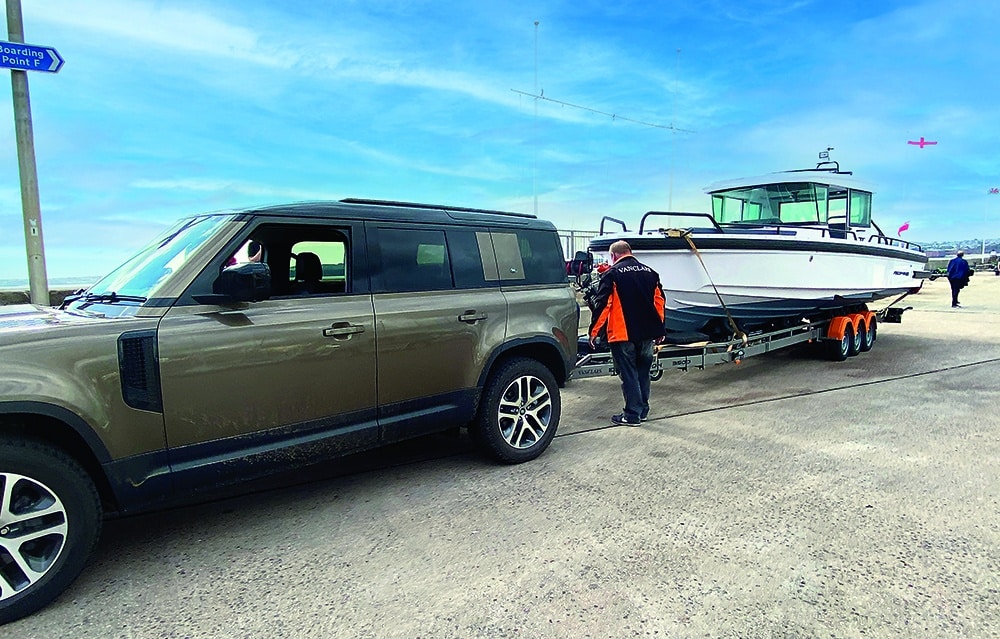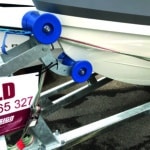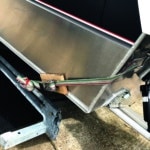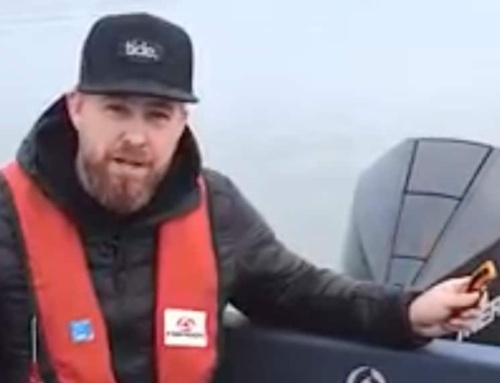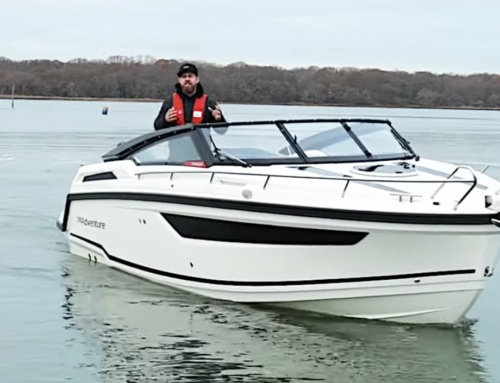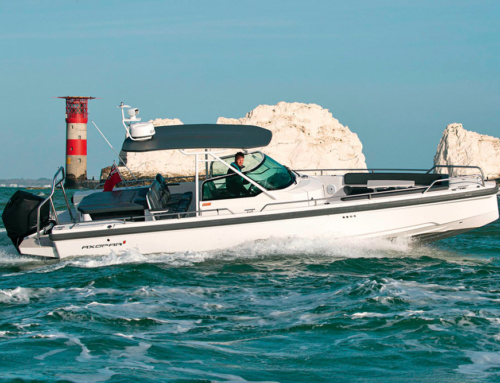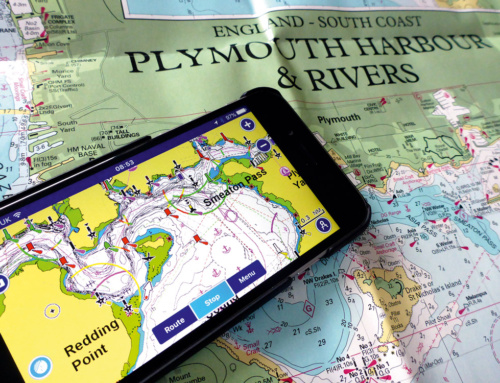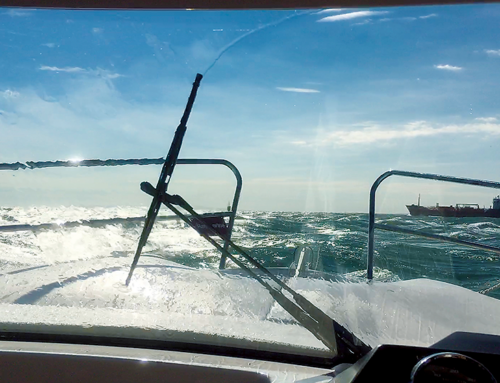As the PBR Axopar team certainly know, around the coast of the UK we are lucky to have some truly amazing locations on our doorstep just begging to be explored. Paul Glatzel asks: will this be the year you get out there and investigate some of them?
On previous circumnavigations of Ireland and England/Scotland I have marvelled at the variety of our coastline, from sheer cliffs to stunning sandy bays and pristine sea lochs. Couple the magnificence of our coast with some great marinas, town quays and yacht clubs that would love to have you visit them and what are you waiting for? Get planning and off you go!
In this article we’re not going to look at the planning of the passage, but rather we’ll examine the practical aspects of heading off with our boat plonked on a trailer and towed behind our (hopefully) trusty tow vehicle.
Let’s start with the basics, as if your boat, trailer and tow vehicle aren’t up to the job, you are going nowhere. The rules surrounding what you can tow and with what vehicle and licence are complicated and are beyond the scope of this article. For more information about the rules on towing, check out the article in our Issue 167 (Beyond the Horizon, An Equitable Marriage, page 126). Additionally my ‘go to’ website is that of the National Trailer & Towing Association (ntta.co.uk). Once you’ve established that you can tow, you need to look closely at your trailer and its suitability for a trip. If the trailer has never been in salt water, then lucky you, as if it’s been dipped even just once you are likely to have some work to do.
Getting a trailer professionally serviced makes sense, but do get it done well before going, and be prepared for it to cost a bit. Almost all boat trailers are essentially a galvanised chassis that is perfect for dipping in water, on top of some electrics and axles that belong on a caravan and were never designed for dipping in any liquid – least of all salt water. Brake shoes and drums and brake cables can quickly deteriorate, so you may need to change these. Before any trip I make sure I get a spare set of bearings for all the wheels (as if one set fails it’s likely the others are not far behind) and the various split pins and nuts that hold the wheels on, and I always have a spare wheel. Make sure you have grease, a suitable jack, a socket set, and plenty of cable ties and gaffer tape. Practising changing a wheel and its bearings and knowing how to repack the grease before you need to be able to do it on the roadside are good ideas too.
Spend more than a few minutes on the Internet and you can easily find plenty of images of boats falling off trailers and landing on the roof of the tow car when it brakes suddenly, etc. How you avoid this is all about securing the boat to the trailer properly, and so often I see it poorly done.
- Tie-down straps are tight to the roller snub and secured from ahead and below.
- Stern tie-down straps are critical to safety. Note the anti-chafe pad.
At the stern (the rear) of the boat you will find a ‘D-ring’ each side of the engine on the transom. My preference is one ratchet strap per side going straight from the D-ring to the trailer. You can rig a strap from the trailer up to a D-ring and across to the other D-ring then down again to the trailer, but the problem with this is that often the strap then pushes tight against parts of the engine, so only use this method if you are sure you are not damaging anything.
Make sure you choose strong enough ratchet straps too – a strap less than 35mm wide is unlikely to be strong enough in the event of a sudden snatch load coming onto the ratchet strap such as when you stop suddenly or crash. Also, think about buying stainless steel ratchets, as salt water onto normal ratchet straps can make the mechanisms hard to use pretty quickly. Get some old bits of carpet to place between the straps and the hull to protect the latter.
You see many boats tied to a trailer with a strap going over the top of the boat at the rear. With RIBs this is totally wrong as you simply cannot ratchet down tight enough over the tube to stop movement and you are going to wear the tube. With a hard boat it could be OK, but I’d recommend using the stern D-rings instead as that’s what they are there for.
At the bow (front) you will have the winch strap attached to the D-ring on the bow – this is great but don’t rely on just this. From the D-ring on the bow I always rig two ratchet straps. One heads backwards from the D-ring to a strong point on the trailer. This is there to arrest forward movement of the boat and is critical, as in a sudden stop the boat is at risk of sliding forward and climbing over the winch post onto the roof of the tow vehicle. This should prevent such an occurrence. The other strap backs up the winch strap and is from the D-ring going forward on the trailer and prevents the boat sliding backwards as you accelerate. Having a third vertically down from the D-ring to the trailer is no bad thing, as with the two rear straps the boat is then locked solid onto the trailer, which is what you want.
Other things to set up on the trailer include ensuring your lights work on the tailboard, making sure the tailboard sits behind the outboard and putting a hi-vis bag over the prop. Before you head off, check that your brake overrun cable is correctly attached and have one final look to ensure the trailer socket sits properly on the towball. The noseweight on the towball should generally be 50–70 kg – a set of scales can help you assess this. Make sure the jockey wheel is secure and possibly add a small ratchet strap to ensure it doesn’t work free.
When I head off towing a trailer, I tend to drive for about 10 minutes, do some firm but gentle braking and then find a safe place to pull over. The straps have always loosened as the boat settles better on the trailer, so tighten up the ratchets and then also carefully feel the wheel hubs. The question is how hot they are – they will be warm but shouldn’t be more than that. Every time you launch, the risk is that you wash out some of the grease; lose too much of the grease and the bearings will overheat and then fail, and a wheel will fall off with potentially catastrophic consequences. This is why you need to regularly check and repack grease in the hubs. Launching with hot hubs increases the risk of grease washing out.
Part of your planning will be where you are going to launch and moor the boat. The Internet is, of course, the ideal resource to help you choose a good slipway, so spend time on Google Maps and read reviews; calling the local harbour master can be a good idea too. Be careful to check out the best route to the slipway over the last mile or two as satnavs tend not to think about you having a trailer behind you and may send you down some sketchy routes.
Once there, park up and take the time to let the bearings cool, prep the trailer/boat, and go and check out the slipway. If there are others launching, watch what they do, and make sure you know if there is a drop at the end of the slipway or perhaps some other issues. Based on this research you can form a plan.
One of your key decisions will be whether you can keep the trailer attached to the vehicle or may need to separate them and use an additional line. Keeping them attached will always be safer. Which you do will depend on the gradient of the slipway, with a shallow angle meaning that a line will probably be needed to keep your vehicle clear of the water.
Your launch process if using a line may well be as follows: Reverse onto the top of the slipway, trailer handbrake on and chocks behind each wheel; keep the winch cable and backup line attached, the jockey wheel down and attach line around a strong point on the trailer and to the tow vehicle. Make sure you use a strong enough line or tow strop. Open the front car windows (so you can escape and easily communicate), take up the strain so that you can remove the chocks and take off the handbrake; then, with a person near the trailer, reverse slowly down the slipway. In an ideal world, you will be able to rig lines, and when the boat floats off, your crew can pull it alongside a wall. Rarely are slipways that nice, though, and you may need to reverse off. If this is the case, it would make sense to get the boat started on a hosepipe before you launch to avoid issues once committed to said launch. Once the boat is in the water you can remove the winch cable and the backup line, but only do this when, if the boat were to roll off, it would do so safely into the water. A pair of waders can make it easier, safer and more pleasant to be involved in the launch, so these are a good investment.
If you are launching with the vehicle attached to the trailer, the process is much the same. Whichever way you launch, take it slowly, as a heavy object on a slope has danger written all over it.
Launching and mooring in different places is a really great way to use your boat, so why not get checking the charts and choose somewhere you’ve always wanted to go and get going.
Have a great trip!
 Paul Glatzel is an RYA powerboat trainer and wrote the RYA Powerboat Handbook and the RYA Advanced Powerboat Handbook. He runs Powerboat Training UK and Marine Education in Poole and Lymington (www.powerboattraininguk.co.uk / www.marine-education.co.uk).
Paul Glatzel is an RYA powerboat trainer and wrote the RYA Powerboat Handbook and the RYA Advanced Powerboat Handbook. He runs Powerboat Training UK and Marine Education in Poole and Lymington (www.powerboattraininguk.co.uk / www.marine-education.co.uk).

